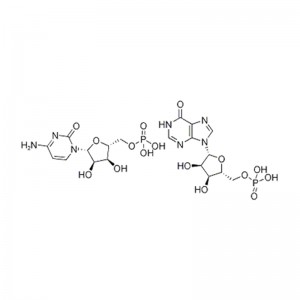
Products
Polyinosinic Acid-polycytidylic Acid
Structural Formula

Physical
Appearance: white or off-white powder
Density.
Melting point.
Boiling point.
Refractivity
Flash point.
Safety Data
Hazardous category.
Dangerous Goods Transport Number.
Packing category.
Application
Poly I:C is known to interact with toll-like receptor 3 (TLR3), which is expressed at the endosomal membrane of B-cells, macrophages and dendritic cells. Poly I:C is structurally similar to double-stranded RNA, which is present in some viruses and is a "natural" stimulant of TLR3. Thus, Poly I:C can be considered a synthetic analog of double-stranded RNA and is a common tool for scientific research on the immune system.
Characteristic
This product is a synthetic interferon inducer, which is a double-stranded polyribonucleotide composed of polyinosinic acid and polycytidylic acid. Since interferon is species-specific, it is difficult to prepare large quantities for clinical application, so it is mostly used as an interferon inducer to induce interferon. In addition, polyinosinic acid still has the role of immune adjuvant, which can stimulate the reticuloendothelial system, enhance the phagocytic function of phagocytes, enhance the formation of antibodies, stimulate allograft reaction and delayed allergic reaction. It has broad-spectrum antiviral and antitumor effects.
Uses and synthesis methods
Overview
Polycytidylic acid, also known as polyinosinic acid, polyhypoxanthine nucleotide and polycytidine nucleotide, is one of the polynucleotides, which consists of a double-stranded polynucleotide chain of polyinosinic acid and polycytidylic acid, with characteristic decolorization and melting point, and stable at -20℃.
Pharmacological effects
1. Polyinosinic acid has a good promotion effect on both specific and non-specific immunity of the body.
(1) Polymyocytes enhance the activity of immune cells
(2) Polymyocytes promote the secretion of various cytokines
(3) Induction of Mx protein by polymyocytes
(4) Polymyocytes promote the production of antibodies in vivo
2. Anti-viral effect of polymyocytes
In vitro tests, animal tests and human clinical trials have proved that polymyxins have a wide range of antiviral effects, including yellow fever virus, encephalomyelitis virus, Rift Valley fever virus, avian influenza virus, hepatitis virus, AIDS virus, foot-and-mouth disease virus, conjunctivitis virus, simple rash virus, Mengo virus, pox virus, myocarditis virus, Aleutian virus, coxsackievirus, etc. It has been proved that the preventive effect of Polymyxa is better than the therapeutic effect of virus infection.
Application
1.A double-stranded homopolymer that can be used as a model RNA to study cell signaling at the level of TLR3 recognizing double-stranded RNA, which is also the main effector of immune response to viral pathogens.
2.Paired with polyinosinic acid to form polyinosinic cell, used for the treatment of viral hepatitis, herpes zoster, herpes simplex keratitis, herpes stomatitis, epidemic hemorrhagic fever, etc.
3. It has immune adjuvant effect, stimulates reticuloendothelial system, enhances phagocytosis, enhances antibody formation, stimulates allograft reaction and delayed allergic reaction. It has broad-spectrum antiviral effect and antitumor effect. Mainly used clinically for: prevention or treatment of viral infections, treatment of herpes zoster, herpetic keratitis, viral hepatitis. Adjuvant treatment of tumors. Adverse reactions mainly include transient hypothermia and individual cases of high fever above 38℃, which mostly subsides on its own within 1-2 days. If the fever does not subside within 2 days, the drug should be discontinued immediately. Weakness, dry mouth, dizziness, nausea, etc. are also seen.








